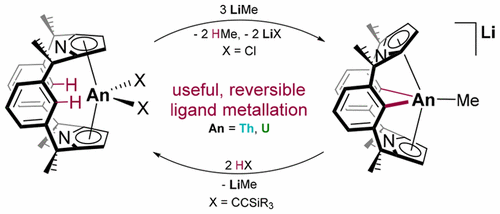当前位置:
X-MOL 学术
›
Organometallics
›
论文详情
Our official English website, www.x-mol.net, welcomes your
feedback! (Note: you will need to create a separate account there.)
Thorium(IV) and Uranium(IV) trans-Calix[2]benzene[2]pyrrolide Alkyl and Alkynyl Complexes: Synthesis, Reactivity, and Electronic Structure
Organometallics ( IF 2.5 ) Pub Date : 2017-10-16 00:00:00 , DOI: 10.1021/acs.organomet.7b00633 Markéta Suvova 1 , Kieran T. P. O’Brien 2 , Joy H. Farnaby 1 , Jason B. Love 1 , Nikolas Kaltsoyannis 2 , Polly L. Arnold 1
Organometallics ( IF 2.5 ) Pub Date : 2017-10-16 00:00:00 , DOI: 10.1021/acs.organomet.7b00633 Markéta Suvova 1 , Kieran T. P. O’Brien 2 , Joy H. Farnaby 1 , Jason B. Love 1 , Nikolas Kaltsoyannis 2 , Polly L. Arnold 1
Affiliation

|
The first thorium(IV) and uranium(IV) hydrocarbyl complexes of a trans-calix[2]benzene[2]pyrrolide macrocycle can use ligand noninnocence to enable multiple C–H bond activation reactions at the metal. Both alkyl and alkynyl complexes supported by the L dianion and L–2H tetraanion are reported. The ThIV and UIV monoalkyl-ate complexes [M(L–2H)An(R)] (M = K for R = CH2Ph, M = Li for R = Me, CH2SiMe3), in which the ligand aryl groups are metalated, add C–H bonds of terminal alkynes across the metal and ligand, forming the AnIV-alkynyl complexes [(L)An(C≡CR′)2] (R′ = SiMe3, SiiPr3). This ligand reprotonation from (L–2H)4– to (L)2– is accompanied by a change in coordination mode of the ligand from η5:η1:η5:η1 to η5:η5. Alternatively, the original alkyl group can be retained if the ligand is reprotonated using [Et3NH][BPh4], affording the ThIV cations [(L)Th(R)][BPh4] (R = CH2Ph, N(SiMe3)2). Here, ligand rearrangement to the κ1:η6:κ1:η6 coordination mode occurs. These complexes provide rare examples of bis(arene) actinide sandwich geometry. The two η1-alkynides in [(L)Th(C≡CSiMe3)2] rearrange upon coordination of [Ni0], forming [(L)Th(C≡CSiMe3)2·Ni(PR″3)] (R″ = phenyl, cyclohexyl), featuring the shortest yet reported distance between Th and Ni and giving unprecedented insight into the changes in macrocyclic ligand coordination between κ1:η6:κ1:η6 and η5:η5 coordination modes. A computational study of this conformational change demonstrates the η5:η5 coordination mode to be more stable in the Th/Ni bimetallics (and hypothetical Pt analogues), an observation rationalized by detailed analysis of the Kohn–Sham orbital structure of the κ1:η6:κ1:η6 and η5:η5 conformers. Although remarkably inert to even high pressures of CO2 at room temperature, the bis(alkynyl) complexes [(L)An(C≡CSiMe3)2] completely cleave one CO bond of CO2 when they are heated under 1 bar pressure, resulting in the formation, and elimination from the metal, of a new, CO-inserted, bicyclic, carbonylated macrocycle with complete control over the C–C and C–N bond forming reactions.
中文翻译:

ium (IV)和铀(IV)反式Calix [2]苯[2]吡咯烷烷基和炔基配合物:合成,反应性和电子结构
反式杯[2]苯[2]吡咯化物大环的第一个or (IV)和铀(IV)烃基配合物可以利用配体无能使金属上的多个C–H键活化反应。由L二价阴离子和L支持的烷基和炔基络合物-2H报告tetraanion。Th IV和U IV单烷基化物配合物[M(L –2H)An(R)](对于R = CH 2 Ph,M = K,对于R = Me,CH 2 SiMe 3,M = Li ),其中配体芳基被金属化,在整个金属和配体上添加末端炔烃的C–H键,形成An IV-炔基配合物[(L)An(C≡CR')2 ](R'= SiMe3,Si i Pr 3)。从(L该配体reprotonation -2H)4-至(L)2-伴随从η在配体的配位模式的变化5:η 1:η 5:η 1至η 5:η 5。另外,如果使用[Et 3 NH] [BPh 4 ]对配体进行质子化,则可以保留原始烷基,得到Th IV阳离子[(L)Th(R)] [BPh 4 ](R = CH 2 Ph, N(SiMe 3)2)。在这里,配体重排到κ1:η 6:κ 1:η 6发生配位模式。这些配合物提供了双(examples芳烃)act系元素夹心几何体的罕见实例。两个η 1 -alkynides在[(L)的Th(C≡CSiMe 3)2时[Ni中协调]重新排列0 ],形成[(L)的Th(C≡CSiMe 3)2 ·镍(PR“ 3)] (R“=苯基,环己基),具有κ之间Th和Ni和给予前所未有的洞察之间的最短尚未报告距离成在大环配体配位的变化1:η 6:κ 1:η 6和η 5:η5种协调方式。这个构象变化的计算研究证明了η 5:η 5配位模式是在的Th /镍bimetallics更稳定(并假设铂类似物),通过κ的科恩深水轨道结构的详细分析合理化的观察1:η 6:κ 1:η 6和η 5:η 5个构象异构体。虽然显着惰性的CO的甚至高的压力2在室温下,将双(炔基)络合物[(L)一种(C≡CSiMe 3)2 ]完全裂开一种CO CO的键2 当它们在1 bar的压力下加热时,会形成一个新的,带有CO插入的双环,羰基化的大环金属,并从金属中消除该金属,并完全控制C-C和C-N键的形成反应。
更新日期:2017-10-17
中文翻译:

ium (IV)和铀(IV)反式Calix [2]苯[2]吡咯烷烷基和炔基配合物:合成,反应性和电子结构
反式杯[2]苯[2]吡咯化物大环的第一个or (IV)和铀(IV)烃基配合物可以利用配体无能使金属上的多个C–H键活化反应。由L二价阴离子和L支持的烷基和炔基络合物-2H报告tetraanion。Th IV和U IV单烷基化物配合物[M(L –2H)An(R)](对于R = CH 2 Ph,M = K,对于R = Me,CH 2 SiMe 3,M = Li ),其中配体芳基被金属化,在整个金属和配体上添加末端炔烃的C–H键,形成An IV-炔基配合物[(L)An(C≡CR')2 ](R'= SiMe3,Si i Pr 3)。从(L该配体reprotonation -2H)4-至(L)2-伴随从η在配体的配位模式的变化5:η 1:η 5:η 1至η 5:η 5。另外,如果使用[Et 3 NH] [BPh 4 ]对配体进行质子化,则可以保留原始烷基,得到Th IV阳离子[(L)Th(R)] [BPh 4 ](R = CH 2 Ph, N(SiMe 3)2)。在这里,配体重排到κ1:η 6:κ 1:η 6发生配位模式。这些配合物提供了双(examples芳烃)act系元素夹心几何体的罕见实例。两个η 1 -alkynides在[(L)的Th(C≡CSiMe 3)2时[Ni中协调]重新排列0 ],形成[(L)的Th(C≡CSiMe 3)2 ·镍(PR“ 3)] (R“=苯基,环己基),具有κ之间Th和Ni和给予前所未有的洞察之间的最短尚未报告距离成在大环配体配位的变化1:η 6:κ 1:η 6和η 5:η5种协调方式。这个构象变化的计算研究证明了η 5:η 5配位模式是在的Th /镍bimetallics更稳定(并假设铂类似物),通过κ的科恩深水轨道结构的详细分析合理化的观察1:η 6:κ 1:η 6和η 5:η 5个构象异构体。虽然显着惰性的CO的甚至高的压力2在室温下,将双(炔基)络合物[(L)一种(C≡CSiMe 3)2 ]完全裂开一种CO CO的键2 当它们在1 bar的压力下加热时,会形成一个新的,带有CO插入的双环,羰基化的大环金属,并从金属中消除该金属,并完全控制C-C和C-N键的形成反应。









































 京公网安备 11010802027423号
京公网安备 11010802027423号